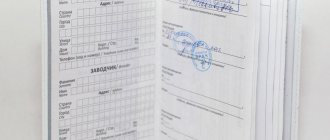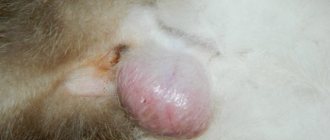A passport for a cat is a document that owners need to travel and move with an animal to a new place of residence outside the territory of the Russian Federation or simply monitor the pet’s health and keep track of whether vaccinations are up to date.
Many countries require this document when traveling abroad. Without a veterinary certificate, a cat is prohibited from entering the territory of the state.
What documents are desirable to have for a dog and a cat?
When buying a puppy or kitten, you can get the first documents from the breeder - this is the purchase and sale agreement and the animal's registration. However, not every breeder can issue such papers.
In Russia, any person can breed animals, but few of them register their nursery as an official organization. Thus, some sellers simply cannot have a formalized purchase and sale agreement and pet registration.
But if you purchased a purebred animal in an official nursery (breeding), then you will definitely be given all the necessary documents. In this case, for the further possibility of your pet’s participation in exhibitions and breeding, you can also complete a pedigree a little later.
But not everyone wants to buy a puppy or kitten. Often our new friends come to us from the street. And, of course, you won’t find any contracts or metrics with them, and it will be simply impossible to draw up these documents from anyone.
In this case, only one document will be in the foreground - the veterinary passport.
Who fills out the veterinary passport and how?
The owner can enter information about himself and the pet, or the doctor can enter information about himself and the pet when registering the animal before vaccination.
Fields for self-entering data:
OWNER OF ANIMAL
"FULL NAME. / Name” – the owner indicates the full name, surname.
“Address” – if the kitten was registered to a breeder, then after purchase the owner changes all the breeder’s information to his own.
DESCRIPTION OF ANIMAL
“Type of animal” – if the cat is purebred and has a metric, then it is filled in as in the pedigree.
“Pet's name” - is given according to the metric; for outbreds - their own nickname.
“Breed” – for outbred animals it is written “mixed breed” or “mongrel”.
“Date of birth” – if it is not known exactly, it is indicated approximately.
“Gender / Sex” – one of the options: “female”, “male” or tick “v”.
“Pet photo” – paste any photo without printing.
“Color” – write it as in the metric, or make a description yourself.
“Special signs / Distinguishing marks” – if any.
What is a veterinary passport and where is the best place to get one?
You can obtain a veterinary passport for cats and dogs in the Alisavet network of veterinary clinics
An international veterinary passport for a dog, cat and other animals is a document that is filled out by veterinarians and the owner throughout the life of the animal. It records the data of the pet, the owner and, of course, records about the preventive procedures performed (for example, treatment for internal and external parasites, etc.).
But the main function of a veterinary passport is to store information about vaccinations performed (vaccinations for cats and dogs). This is the most important thing for any of your movements with an animal in cities within the country and when traveling abroad.
Where can I get a veterinary passport:
- Pick up from the breeder at the time of purchasing the animal (but not always). Usually, practically nothing is filled out in the proposed passport, and the notes on the treatments and vaccinations performed are not confirmed by the seals of the veterinary clinic and the veterinarian. Sometimes the passport already has a rabies vaccination stamp, but usually you won’t see the registration number there. If this is so, in your hands for now there is only a “filkin’s letter”. But this can be fixed - at the first vaccination in the veterinary clinic, the doctor will make all the necessary notes and stamps.
- Buy at a pet store or veterinary pharmacy. You can buy a veterinary passport yourself and fill out the necessary sections in advance (this is written in great detail below in the article). The purpose of such a preliminary purchase is to buy a passport that you like in appearance (the ability to choose), and you will also be able to fill it out carefully and neatly without errors. At this stage, your purchased passport until your visit to the veterinarian is still invalid.
- Receive from a veterinarian during the first vaccination of the animal - the doctor fills out the necessary fields, signs and seals. In this case, you will immediately receive an officially executed document. The veterinarian usually allows you to obtain more detailed information about the pet and the owner at home.
Filling out a veterinary passport by a veterinarian
Thus, it does not matter where you got your veterinary passport from. Only one thing is important - in the end, it must be correctly executed, in accordance with the approved federal law on veterinary medicine.
Unfortunately, some owners still refuse to obtain a veterinary passport at a veterinary clinic and, in order to save money, prefer to vaccinate themselves.
We have nothing against it: it makes no difference where the animal was given a high-quality vaccine - at home or in the clinic. It will work in any case. But here the question is different - how to prove to others that the vaccination was really done? And to whom and why to prove this - read on.
Types of veterinary passports
A veterinary passport is a registration certificate for a pet, which contains the history of vaccinations, the type of animal, and information about the owner.
- domestic model, valid where the owner and the pet live;
- an international standard (or an international veterinary vaccination certificate), which allows you to import an animal into another country, and the entries here are in both your native and English languages;
- universal pattern, suitable for all types of pets, such as cats, dogs, ferrets.
In document forms from different manufacturers, differences in appearance and number of pages are acceptable.
What is the value of a veterinary passport?
Unfortunately, not everyone understands why a veterinary passport is needed for a dog, cat, ferret or rabbit. And it’s even more difficult to imagine how it can save you from possible lawsuits.
There are only 3 reasons to obtain a veterinary passport:
- This document makes it possible to monitor the health of your pet. Namely: know the exact dates of vaccinations, various treatments against parasites and operations performed. It's comfortable. It is unlikely that you circle the required dates in a red circle on the calendar and then store the torn pages as an archive. But once every six months it won’t be difficult to look into the treasured book.
- An international veterinary passport will allow you and your pet to be anywhere in the world. With the help of a correctly executed document, there are no problems in obtaining the necessary certificates for the export of an animal. And if it seems to you that you will never go anywhere with your dog or cat, believe me, there are different cases.
- And here is the third reason, about which there are so few words. Animals are animals, and no matter how gentle and affectionate your pet is, there will always be a provocateur for an aggressive reaction. And this will not mean at all that your dog or cat is solely to blame.
Most often, animals are simply trying to protect themselves or their offspring. And there can be quite a few provocateurs for aggression - often these are children who do not yet know how to properly treat our smaller brothers, as well as people who do not like four-legged animals or are terribly afraid of them. In this case, biochemical reactions play an important role, due to which complete antipathy arises between a person and a particular animal.
“Bitten by a dog”, “bitten by a cat” are some of the common reasons why people go to emergency rooms. We sincerely hope that you never have to literally “tear” your dog away from a person or another dog. But if this happens, show respect and first apologize. We are sure that you are a prudent and sensible person who will not blame anyone except yourself and your pet for this situation. They can bite anytime and anywhere, including you or your animal - that’s life. There is no need to make a scandal during such a stressful situation - emotions will easily flare up from any spoken word.
In addition to apologizing, you should immediately offer to provide assistance to the victim and provide your pet’s veterinary passport. If your animal has received all the necessary vaccinations, including vaccination against rabies, then you give the victim the opportunity not to torment himself with the question - is there a risk of contracting rabies or not? In this case, the risk of contracting a fatal viral disease is practically absent.
In any case, final conclusions can be drawn only after a general examination of the animal by a veterinarian and if there is a note in the veterinary passport about the vaccination. Without official confirmation that your pet has received a rabies vaccine, you doom the person to specialized medical treatment.
In addition, the victim may sue you, where he will have to prove that you did not deliberately set your dog on this citizen and that in no case did you want to be a participant in the spread of a dangerous viral infection. Believe me, there are no such lawsuits.
Do not think that this can bypass you - anyone can be a victim, including yourself. At least now you know that there is a very important document - a veterinary passport, which, together with your respect for the victim, will help eliminate unpleasant consequences in the future.
International format document
The international document is no different from the standard one, the only thing is that all data is duplicated in English or German. This allows you not to provide translation papers when transporting abroad. However, for the flight you will need to obtain a certificate form No. 1 from the clinic.
A European passport is issued at a licensed medical institution, where they will issue the necessary document, according to which the owner will be able to transport the cat without additional certificates and certificates.
Filling out a veterinary passport is the task of a veterinarian
After looking through the veterinary passport, you will notice that your share of filling it out is limited only to entering basic data about the animal, information about the breeder and about yourself as the final owner of the pet.
Therefore, having once filled out the first columns of your passport, you can now safely pass the baton to the doctors of veterinary clinics. The fact is that a veterinary passport is considered an official document only if it bears the seals and signatures of veterinary specialists.
Filling out an international veterinary passport at the Alisavet veterinary clinic
But so that you understand what the doctor writes in your pet’s veterinary passport and why this is necessary at all, the following explanations will not be superfluous.
Column “Pet card number”
This section is not included in all veterinary passports. It makes sense to fill it out if you are always seen at the same veterinary clinic - the doctor simply writes down the number of your pet’s outpatient card. If you visit different veterinary clinics, then filling out this section does not make sense.
Columns “Microchip number” and “Barcode”
This section must be completed at the veterinary clinic immediately after your pet is microchipped. Chipping is radio frequency identification of animals using special microchips.
An identification microchip is a miniature electronic circuit containing a unique 15-digit code according to the ISO 11784/11785 standard. The first three digits are the country code, the next 4 are the manufacturer's code, and the last digits are the unique animal code.
Decoding the identification microchip number
The manufacturer attaches from 3 to 5 identical barcodes to each microchip. The veterinarian will paste one barcode into the animal registration log for full reporting of his actions to higher authorities.
The doctor will paste the second barcode into the required column of your pet’s veterinary passport, and will simply give the rest to you in case the documents are lost or damaged - this way you can easily restore your passport at any veterinary clinic.
The microchip is injected subcutaneously into the animal once using a special device - the procedure is unpleasant, but completely safe. It is advisable to introduce a microchip BEFORE vaccination. This will officially prove that all vaccinations are given to your pet and not to anyone else.
Since the chip itself contains only a set of numbers (and nothing more!), after microchipping, the veterinarian is obliged to immediately enter detailed information about the animal and its owner into a single database. This is necessary to associate the entered microchip number with a specific pet and its owner.
When traveling when crossing the border, employees can use a special scanner to check the microchip number and compare it with the number included in the veterinary passport. The correspondence of the 15-digit number proves that exactly the animal specified in the document is being transported to the country.
Also, a microchip can play a positive role if a pet is lost or an animal is found on the street. Having found out the chip number at the veterinary clinic, there is a high chance of finding the owner of the lost item. But you should know that not every medical institution has a special scanner.
Columns “Date of microchip implantation” and “Location of microchip placement”
These sections are also completed by the veterinarian immediately after microchipping the animal. The date of insertion of the chip must be real. On the same day, all the necessary information must be entered into a single database.
The location of the microchip is usually the skin in the area of the withers or any shoulder blade. The veterinarian will enter in the column exactly the information where he entered the microcircuit (for example, the area of the left shoulder blade).
Please note that sometimes the microchip may move from its insertion site. Therefore, when scanning an animal, it is advisable to take a larger body coverage. By the way, you can easily find out if an animal has a microchip or not - just take an X-ray. Of course, you won’t see the 15-digit number, but it’s not difficult to see the microchip itself in the resulting image (a veterinarian can help you).
Column “Veterinary Certificate” – section “Registration”
This section is filled out by a veterinarian only when your pet is given a rabies vaccine (an example of filling is published above). The registration number in the passport must correspond to the number in the animal registration register, which the veterinarian fills out immediately after vaccination. The date must be valid, which will also be confirmed by the data in the registration journal of the veterinary clinic.
All registration logs are ultimately transferred to a higher organization - SBBZH (station for combating animal diseases of a certain district). Thus, the vaccine number will become officially registered for a specific pet, which eliminates any problems with paperwork. Information about vaccinations and microchipping is stored in the SBBZ for several years.
Also in the “Registration” column, the doctor writes his last name and initials, after which he puts his signature and two seals:
- one oval or rectangular seal of a medical institution (with the full name of the veterinary clinic and contact information);
- the second is the veterinarian’s personal seal (usually round in shape), which fully displays the specialist’s last name, first name and patronymic.
Stamps must appear on handwritten notes with at least one edge - this confirms the accuracy of the information entered.
The veterinarian fills out the veterinary passport and stamps it
When vaccinating against other diseases, the veterinarian does not fill out this section.
Boxes for marking administered (used) vaccines
In different veterinary passports, this section can be formatted differently:
- if the cover does not say which animal this document is for, then the columns usually have the following columns: date, type of vaccine, series number, veterinarian’s signature and seal (in this case, the doctor simply writes down the records of vaccinations done one after another);
Sample of filling out the vaccination section in a veterinary passport
- if on the cover of the veterinary passport it is written for whom it is intended (cat, dog), then the headings usually clearly indicate what mark each column is for.
Possible sections in the veterinary passport about vaccinations given
In this case, the doctor makes notes about the vaccinations performed in the appropriate sections: the vaccination against rabies is recorded in one column, the complex vaccine in another, and the vaccination against dermatophytoses in the third. Although vaccination against dermatophytes has long been discouraged.
Column “Deworming, treatment against fleas and ticks”
In this section, entries can be made by both the veterinarian and the owner.
If you are administering a deworming medication yourself and are treating it for external parasites, then your task is to enter the date of treatment, the name of the drug used (a sticker is often included) and its dosage. In this case, the entry will remain without the veterinarian’s stamp (without official confirmation).
When planning a trip to another country, it is advisable to have the necessary treatments done by a veterinarian at your appointment. Then immediately ask him to fill out this section of the passport, sign and stamp the medical institution.
The requirements in each country are different and change quite often, so all the details before completing the documents should be clarified in advance with the SBBZH of your district (this institution ultimately issues the final documents for the export of the animal). You can also find out detailed information about the rules for transporting pets at the consulate of a certain state or from tour operators who enter into an agreement before traveling.
Sample of filling out sections “Deworming” and “Diagnostic tests” in a veterinary passport
Column "Diagnostic studies"
It is not necessary to fill out this column, but it is recommended - this way you will not forget when and what important studies were carried out on your pet, and this can help the veterinarian navigate an emergency situation if there is no outpatient card at hand. Of course, it is impossible to fit a lot of information into such a section, but it is better to write down the most important ones.
Other graphs
Also, an international veterinary passport for a dog or cat may contain the following sections:
- reproductive health - information about castration, sterilization of a cat or dog, pregnancy, childbirth and even the number of newborns;
- special notes - for recording any important information that it is desirable to record, but there is no corresponding column;
- and so on and so forth.
These fields are not strictly required to be filled out. But if they are present in your pet’s document, then it is advisable to fill them out as needed.
Also in passports you can find pages with useful information:
- physiological indicators (body temperature, respiratory rate, etc.);
- reminders on preventive procedures (dog vaccination, cat vaccination, treatment for worms, fleas, ticks, etc.);
- possible diets and nutritional advice.
You have learned a lot of information about important documents in your pet's life. But if we could not answer all your questions about how to fill out a veterinary passport for a dog or cat, then be sure to fill out the form for a call back. We will not only tell you how to do this, but also tell you how to properly prepare your animal for the upcoming vaccination.
What should be indicated in the veterinary passport
To ensure that at customs or at exhibitions there are no questions regarding the correct filling out of the passport, the cat owner must check the document for the presence of:
- Owner contacts (full name, address, phone number).
- Data about the pet (name, gender, date of birth, breed, color).
- Information about a chip implanted in a cat's paw. Helps identify a lost pet and transport it abroad.
- Stamp of a veterinary clinic (necessarily licensed) and doctor’s signature.
- A list of all vaccines that were given to the animal (against rabies, panleukopenia, calcivicirosis). Routine vaccination is done once a year. The passport indicates in the form of a sticker with the name of the drug, the date and signature of the specialist.
- All treatments for ticks, fleas and helminths. Deworming is carried out once a quarter.











